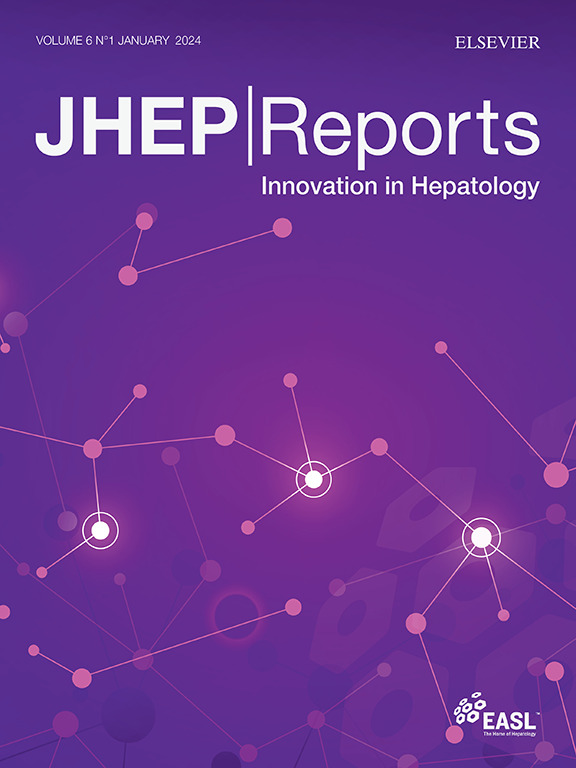PNPLA3 I148M变异与禁食和饲养期间MASLD的不良代谢性状有关
IF 7.5
1区 医学
Q1 GASTROENTEROLOGY & HEPATOLOGY
引用次数: 0
摘要
背景,PNPLA3 rs738409多态性是与代谢功能障碍相关的脂肪性肝病(MASLD)向脂肪性肝炎(MASH)和纤维化进展相关的最丰富的遗传危险因素。虽然禁食和喂养会影响PNPLA3的表达,但对病理生理影响的分子见解仍然很少。方法采用核磁共振-蛋白质代谢组学方法对来自德国两个三级中心的353例MASLD患者的血清样本进行分析。患者按PNPLA3 rs738409 C>;G基因型进行分层:“CC”、“CG”和“GG”。根据空腹状态评估代谢物、脂蛋白和糖蛋白。结果spnpla3gg在空腹和非空腹状态下表现出明显的代谢特征。在后者,GG携带者表现出较低的VLDL-1水平,反映了肝细胞中甘油三酯(TG)外排受损。禁食一夜后,GG携带者表现出更高的三羧酸循环代谢物和酮体,总体上表明β-氧化增加可能是由于PNPLA3表达降低,促进脂肪甘油三酯脂肪酶活性不受限制,肝脏TG分泌持续增加。此外,对线粒体肉毒碱运输至关重要的生酮氨基酸赖氨酸显著降低(GG为0.14±0.09 mM, CC为0.18±0.08 mM, q = 0.015)。与此一致的是,tg在LDL和HDL颗粒中富集,中密度脂蛋白数量的增加成为空腹GG携带者的明显标志(GG为202.9±68.2 mg/dl,而CC为160.8±65.6 mg/dl, q = 0.007)。这些代谢变化在2型糖尿病和/或肥胖患者中增强。结论pnpla3gg携带者在进食时肝脏脂质储存增加,空腹时脂质氧化过度,超过代谢能力,诱导细胞毒性。这种相互作用加剧了有害的禁食/非禁食循环,因此需要采取预防策略。影响和意义PNPLA3 rs738409 (p.I148M)多态性是代谢功能障碍相关脂肪变性肝病进展最普遍的遗传危险因素,受禁食和喂养周期的影响。然而,这种调节的病理生理后果仍然知之甚少。核磁共振-蛋白质代谢组学揭示了纯合子PNPLA3 GG携带者的独特特征,该特征随禁食状态显著变化,为诊断和预防策略提供了重要意义。本文章由计算机程序翻译,如有差异,请以英文原文为准。

PNPLA3 I148M variant links to adverse metabolic traits in MASLD during fasting and feeding
Background & Aims
The PNPLA3 rs738409 polymorphism is the most abundant genetic risk factor associated with progression of metabolic dysfunction-associated steatotic liver disease (MASLD) to steatohepatitis (MASH) and fibrosis. Although fasting and feeding affect PNPLA3 expression, molecular insights into the pathophysiological influence remain scarce.
Methods
We analyzed 353 serum samples of patients with MASLD from two German tertiary centers using nuclear magnetic resonance (NMR)-proteometabolomics. Patients were stratified by PNPLA3 rs738409 C>G genotype: ‘CC’, ‘CG’, and ‘GG’. Metabolites, lipoproteins, and glycoproteins were assessed based on fasting status.
Results
PNPLA3 GG displayed a distinct metabolic profile, with notable alterations between fasting and non-fasting states. During the latter, GG carriers showed lower levels of VLDL-1, reflecting impaired triglyceride (TG) efflux from hepatocytes. Following an overnight fast, GG carriers exhibited higher tricarboxylic acid cycle metabolites and ketone bodies, overall indicating increased β-oxidation likely attributed to lower PNPLA3 expression, facilitating unrestricted adipose triglyceride lipase activity and consecutive increased hepatic TG secretion. In addition, the ketogenic amino acid lysine, critical for mitochondrial carnitine transport, was significantly reduced (GG 0.14 0.09 mM vs. CC 0.18 0.08 mM, q = 0.015). Consistently, TGs were enriched in LDL and HDL particles, and an increased number of intermediate-density lipoproteins emerged as a distinct marker in fasted GG carriers (GG 202.9 68.2 mg/dl vs. CC 160.8 65.6 mg/dl, q = 0.007). These metabolic changes were enhanced in patients with type 2 diabetes mellitus and/or obesity.
Conclusions
Our findings suggest a dichotomous pattern of increased hepatic lipid storage during feeding and excessive lipid oxidation during fasting, which exceeds metabolic capacity, inducing cellular toxicity in PNPLA3 GG carriers. This interplay fuels a detrimental fasting/non-fasting cycle, thus pointing to the need for preventive strategies.
Impact and Implications
The PNPLA3 rs738409 (p.I148M) polymorphism is the most prevalent genetic risk factor for metabolic dysfunction-associated steatotic liver disease progression and is influenced by fasting and feeding cycles. However, the pathophysiological consequences of this regulation remain poorly understood. Nuclear magnetic resonance-proteometabolomics reveals a distinct signature in homozygous PNPLA3 GG carriers that changes significantly with fasting status, providing important implications for diagnosis and preventive strategies.
求助全文
通过发布文献求助,成功后即可免费获取论文全文。
去求助
来源期刊

JHEP Reports
GASTROENTEROLOGY & HEPATOLOGY-
CiteScore
12.40
自引率
2.40%
发文量
161
审稿时长
36 days
期刊介绍:
JHEP Reports is an open access journal that is affiliated with the European Association for the Study of the Liver (EASL). It serves as a companion journal to the highly respected Journal of Hepatology.
The primary objective of JHEP Reports is to publish original papers and reviews that contribute to the advancement of knowledge in the field of liver diseases. The journal covers a wide range of topics, including basic, translational, and clinical research. It also focuses on global issues in hepatology, with particular emphasis on areas such as clinical trials, novel diagnostics, precision medicine and therapeutics, cancer research, cellular and molecular studies, artificial intelligence, microbiome research, epidemiology, and cutting-edge technologies.
In summary, JHEP Reports is dedicated to promoting scientific discoveries and innovations in liver diseases through the publication of high-quality research papers and reviews covering various aspects of hepatology.
 求助内容:
求助内容: 应助结果提醒方式:
应助结果提醒方式:


